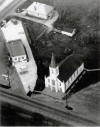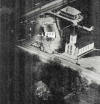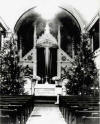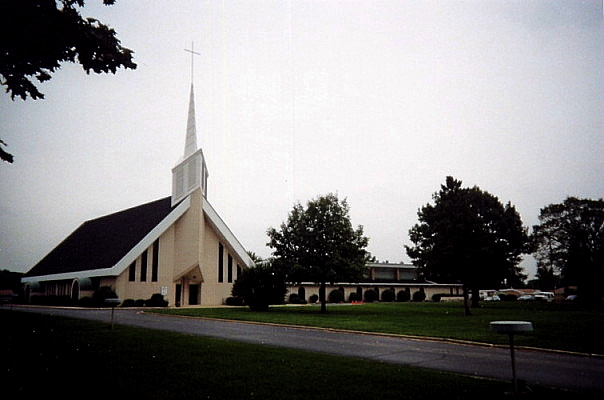www.FranzosenbuschHeritageProject.org Home
Immanuel Lutheran Church, Hillside, Illinois
Established 1858
Church and School
2317 South Wolf Road
Hillside, IL 60162
(708) 562-5590
www.immanuel-hillside.org
Pastor Patrick McKenzie
- AN EARLY HISTORY OF THE CONGREGATION
In order to understand the story of Franzosenbusch, we must begin with the history of Immanuel Lutheran and its influence upon many of the surrounding communities. Hillsideís Immanuel Lutheran Church (itself, a daughter church of Zion Lutheran Church in Bensenville, Illinois), was the mother parish for churches in Forest Park, Hinsdale, Western Springs, La Grange, Lyons, Willow Springs and Bellwood, Illinois. It had its beginning in the year of 1858. A short history entitled, "Chronik " was entered in the churchís record book during the pastorship of Rev. Johannes Strieter, third pastor of ILC, (1873 Ė 1902). In this brief summary Rev. Strieter looks back and records the important events in the years prior to the founding of the congregation:
"On November 27th, the local Lutherans organized themselves into an independent community (parish) under the name of The Southern Evangelical Lutheran Immanuel Parish of Proviso, Cook County, Ill. The first pastor was C. Meyer, the first record of the gathering dates from December 8, 1858."
1840 - 1850
: Earliest Settlers Lay the FoundationIn the mid to late 1840s German settlers from the Kingdom of Hanover {Germany}, Pomeranian and Prussia began moving into an area located in southwestern Cook County, near the intersection of Wolf and 22nd Streets. At that time, there were no established towns in the immediate vicinity and the nearest homesteader to the German farmers was a man named Nicholas Torode, located in a woody area called "Frenchmanís Woods". This was approximately 3 miles west, (as the crow flies), in DuPage County, roughly at the intersection of York and Roosevelt Roads. The wooded area was named for Mr. Torode, who settled there in 1835
1A and who, at the time, was the only French man in a predominantly "Yankee" and German area. Many German farmers, then living in close proximity to Frenchmanísí Woods, called their own settlement "Franzosenbusch", which literally means, "French Bush", or "Frenchmanísí Grove" in the German language. In 1850 the Frenchmanís Woods area in DuPage County became part of the newly formed York Township and also in that same year, the little German settlement of "Franzosenbusch" became part of the new Proviso Township in Cook County. Some of the earliest German settlers in the Franzosenbusch area in Proviso Township were; Heinrich Mesenbrink Sr. of Hanover, Germany in 1840, -section 19, Christian G. Puscheck of Pomerania in 1846 -section 28, George Darmstadt and C. Limberee - section 18 in 1845, and D. F. Diebert and H.F. Diebert - Section 7 in 18481B.NOTE: The Franzosenbusch settlement was often referred to simply as, "Proviso". This was in spite of the fact that there was no actual town of that name in Proviso Township. During our research at the Clerkís office of Proviso Township in 2000, we noted that in early records "the words " town of Proviso" and the " Township of Proviso" were often employed simultaneously.
1852: Origins of The Immanuel Lutheran Congregation property in Hillside, Illinois
In 1852 a small band of these immigrant farmers - many having just arrived from Hanover, Germany - purchased 40 acres of land for what was to become their first school and church on the southeast corner of 22nd Street and Wolf Road in section 29. (Now part of Hillside). However, for the next eight years these settlers continued to attend services at their mother church, Zion Lutheran in Churchville, (now Bensenville). (The origins of their mother church, Zion Lutheran congregation, can be traced to back even further, to the early 1830ís and to another pioneer settlement called "Dunklee's Grove". (see Zion Lutheran Church). When the roads were impassable for teams, the families walked the distance of ten miles to the church in Addison Township, and in order to attend regular confirmation classes, the children also walked this route - often in bad weather and sometimes even without shoes.
Fall, 1852: A new school district is established at Franzosenbusch. Children meet in the home of Heinrich Degener for school
"The fact that Proviso had no church and no school was a problem, in particular for the dear children. Regular attendance at school was completely out of the question in view of prevailing circumstances. However the situation gradually improved for in the same year, 1852, nine family heads banded together to form a new school district located in "Franzosenbusch". The participants were: Heinrich Mesenbrink, Heinrich Degener, Friedrich Meyer, Friedrich Degener, Friedrich Volberding, Heinrich Volberding, Wilhelm Mandel, Christina Puscheck and Heinrich Evers."
2"Initially, Teacher Bartling from Addison (Zion Lutheran), provided three days of instruction in the home of Mr. Heinrich Degener. "In October of the same year (1852), the district got its own teacher in the person of Mr. Hahn. The school (still meeting in the home of H. Degener) had an enrollment of about 15 children".2 (Many streets in the immediate vicinity are named after these founding pioneers)
Spring, 1853, The first school building and teacherís quarters is constructed.
..."The following spring, {in 1853}, the Proviso people built their own school".
2 It had two rooms, one a classroom and the other, living quarters for the first resident teacher, Mr. Hahn. The teacher taught seven grades and the children were strictly disciplined. The older children sat with the younger to help with the lessons and all took turns sweeping and cleaning the classroom.) For a time, church services were conducted in the schoolhouse in the German language (This original settlement structure is the one that forms the core of the current "Franzosenbusch Prairie House"). See Immanuel Lutheran School. Teacher H. Bartling of Dunklee's Grove taught classes in the German language (High German) three times a week for fifteen pupils in Henry Degener's home.2"From the very beginning Proviso did not regard itself the sole beneficiaries of Godís blessings, the Gospel. Its pastors were active in missionary work and organized new congregations in the vicinity. As early as 1859 Pastor Meyer went to Lyonsville, the present Willow Springs, and in 1860 to Oak Ridge or Harlem. Pastor Strieter served Lyons and released LaGrange and Hinsdale to become independent congregations. Downers Grove too was served from Proviso. More recently Bellwood likewise shared in its ministry."
After the initial formation of the Immanuel Lutheran Church In 1858 the following members of the Zion Church asked to be released from that church to join Immanuel Lutheran.
The Congregation soon grew from fifty to one - hundred and twenty-five families. One can safely assume that this first "gathering" of the congregation must have taken place in the new schoolhouse, having been completed earlier in the year of 1858.2 because according to ILC records, the newly organized congregation did not have its own dedicated church building until the year of 1868.3
For more on the first schoolhouse, please also see Schoolhouse -- 1852 or 1853 or Immanuel Lutheran School.
1858: A
second schoolhouse is built
The 1858 schoolhouse ó the second schoolhouse ó has often mis-identified as the first schoolhouse. For according to several early church records, a separate structure for the school, church, and teacherís quarters was built prior to this one, in 1853. Remnants of the 1853 schoolhouse exist to this day and form the early structural core of the Franzosenbusch Prairie House. Schoolhouse -- Restoration of the Schoolhouse. By 1857 the little school and teacherís quarters had outgrown its usefulness and in 1858 a new schoolhouse -- also to be used as a church --was built and located on the SE corner of Wolf Road and 22nd Street. Its front door faced Wolf Road.
1859: The first parsonage is completed, ILC joins the Missouri Synod.
In 1858 Reverend C. Meyer, boarded with the Henry Ehrenpforts until the parsonage was completed in 1859. The newly organized congregation became a voting member of the Missouri Synod as early as 1859.
21864: In 1864 "Pastor Meyer accepted a call to Kankakee."
Pastor George M. Zucker was called and served the congregation from 1864 to 1873.
2
1868: Immanuel Lutheran builds its first church
In 1866 the congregation had already began to consider and discuss building a church.
2 Two years later the Immanuel Lutheran Church was built.2 It was completed and dedicated in 18683 ten years after the establishment of the congregation and located on Wolf Rd on the church property, just south of the second schoolhouse at the southeast corner of 22nd Street and Wolf Road. The words "Ehre Sei Gott in der Hoehe" (Glory to God in the Highest) were inscribed on the arch above the altar, and above the entrance "Be Ye Doers of the Word" guided the congregation of Provisoís historic church. Immanuelís white Gothic structure was destined to stand for over 100 years and became known as the historical church and one of the fifty landmarks in Northern Illinois.Above is the 1858 school north of the new church.
The church was often the subject of artists, one being a 24"x30" watercolor painting done by artist John McKee, and widely exhibited in 1947 by the Public Service Company of Northern Illinois in their "Our Landmarks" series. On March 16, 1873 Pastor Zuckerís successor, Pastor Johann Strieter, was installed March 16.2
1910: A third schoolhouse is built, just east of the second schoolhouse along 22
nd Street.
1933: First disaster strikes Immanuel Lutheran Church.
When a cyclone passed over the church property on Sunday, July 2, 1933, it ripped away the high steeple and although it was replaced, steeplejacks were scarce and the steeple was lowered by thirty feet.
In 1945 The Reverend Dr. Pittelko became the seventh pastor to serve Immanuel Lutheran. The church interior, however, was completely renovated in 1958 for its centennial celebration and a telegram was received from the White House:
"To the members and friends of Immanuel Lutheran Church joined in the observance of the 100th anniversary, I send greetings. Over the past 100 years, by faith and work, your congregation has contributed much to the life of the Hillside community. Strengthened by a great tradition, your church enters its second century with confidence and thanksgiving.
Congratulations and best wishes."
Dwight D. Eisenhower (Pres.)

 Aerial
views with the Immanuel Lutheran near the center of the picture of the picture
on the left. (Click on any of the blue-boxed pictures to expand the view.)
Aerial
views with the Immanuel Lutheran near the center of the picture of the picture
on the left. (Click on any of the blue-boxed pictures to expand the view.)
In the picture on the right we see the church with the gas station to the left of the church. The gas station was replaced by the strip mall at Wolf and Cermak Roads (22nd Street). The third Immanuel Lutheran schoolhouse sits in the top center of the photograph.
 In
a similar aerial photo the Franzosenbusch Prairie House (which contains the
structure of the first Immanuel Lutheran schoolhouse) can be seen in the lower
center -- below and a bit to the left of the church. This is the location
the first schoolhouse had been joined with another structure to become a
residence for many years. .It was not until the 1980's that the house was
moved to its current location on Constitution Drive.
In
a similar aerial photo the Franzosenbusch Prairie House (which contains the
structure of the first Immanuel Lutheran schoolhouse) can be seen in the lower
center -- below and a bit to the left of the church. This is the location
the first schoolhouse had been joined with another structure to become a
residence for many years. .It was not until the 1980's that the house was
moved to its current location on Constitution Drive.
Photo credits are unknown for these aerial photographs.
 1975: Final disaster -- Fire destroys the church
1975: Final disaster -- Fire destroys the church
One rainy Friday evening, January 24, 1975, the 107- year- old frame
structure was encircled in a blaze of glory and four hours later only the
charred ruins remained. Benches, books, altar, organ and appointments were gone,
but fortunately, the bell and a fireproof safe containing all the records of
baptisms, confirmations, marriages and burials for more than 100 years were
saved. With the same spirit of sacrifice felt by the early founders, Immanuel
knew it must build a new church ó this to be fireproof, preferably of white
brick with a cloister walk to encompass the Lutheran school building and a bell
tower to rise gracefully to a height of eighty feet. The original bell was
placed in an open garden separating the Church building from the school
building.
Services continued in the school gymnasium until September 11, 1977, the day of Dedication, when Immanuelís congregation met once more in the gymnasium and followed Dr. Elmer H. Pittelko, pastor of Immanuel, into the new church building, the old no longer a heartache but now a blessed memory.

Photo of Immanuel Lutheran Church and School in October of 2002 by Jim Arbuthnot
The following have served as pastors of the Immanuel Lutheran Church from 1858 to the present day*:
1858 - 1864: Rev. Carl Meyer
1864 - 1873: Rev. George M Zucker
1873 - 1902: Rev. John Strieter
1902 - 1905: Rev. Christopher Droegemueler
1905 - 1928: Rev. Henry Roehrs
1929 - 1944: Rev. Otto Heerwagen
1945 - 1981: Rev. Dr. E. H. Pittelko
1981 - 1993: Rev. Dr. Robert L. Nordlie
1986 - 1990: Rev. Dr. Philip M. Bickel
1990 - 1993: Rev. Steven D. Simon
1994 to Present: Rev. Patrick McKenzie
Sunday services: 8:15 and 11:00 a.m.
*The information is taken from Immanuel Lutheran Church material regarding the 140th anniversary of the congregation, printed in 1998.
Also see the
Immanuel Lutheran Cemetery and Local Church Parent of 9.This information was compiled and edited by Lana Gits, an FHS historian, and Jim Arbuthnot, (webmeister). With a special note of thanks to:
Bibliography:
1 "The Lutheran Trail : a history of the Synodical Conference Lutheran churches in northern Illinois" by Schwartzkopf, Louis J., St. Louis: Concordia Pub. House, c.1950
1A ĎHistory of DuPage County, Illinois" by Rufus Blanchard. C. 1882, Baskin and Co. Chicago Illinois.
1B Andreas, Alfred Theodore, " History of Cook County, Illinois". Chicago, A. T. Andreas, 1884.
2 Concordia Historical Institute Quarterly, Summer,1985, "Immanuel Congregation, Proviso, Illinois written by Heinrich Roehrs after a translation of the Golden Jubilee Booklet of the Evangelical. Lutheran Immanuel Church in Proviso Illinois, 1858-1908. (This article was written by his father, H. Roehrs, former Pastor of Immanuel Lutheran) pages 51 through 57.
3 "Progress, Pride, Growth, 1905 - 1980, 75th Anniversary óVillage of Hillside", C.1981 published by Village of Hillside, Hillside, IL, by Ruth Lommatzsch and Ann Hoogstra
4 Centennial of Zion Evangelical Lutheran Church, Churchville, Illinois, near Bensenville, Addison Township, DuPage Co., 1838-1938" Pages 1 through 8).
The Immanuel Lutheran Church's website is: www.immanuel-hillside.org
Last Modified: 10/30/2003